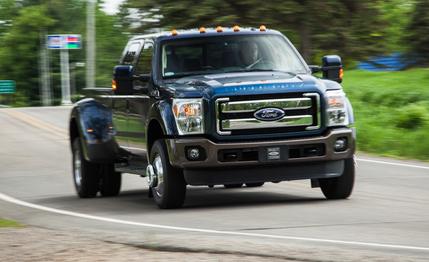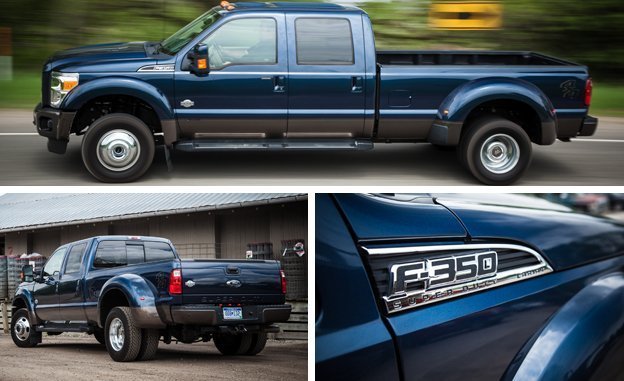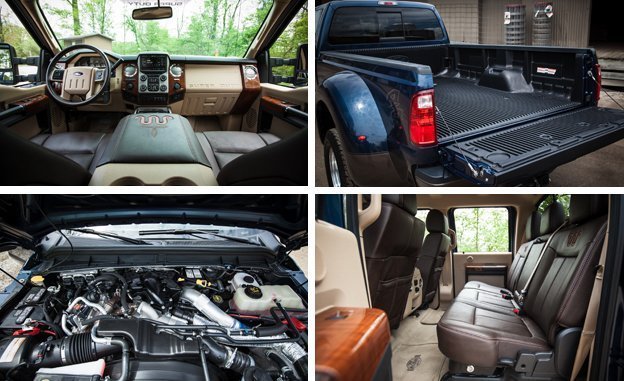
 Instrumented Test
Instrumented Test
Eight thousand, five hundred and twenty pounds—that's how much our big-as-it-can-get Ford F-350 dualie test truck weighs. Its eight-foot bed and spacious crew cab help contribute to an overall length that’s an inch shy of 22 feet, or four feet longer than a Mercedes-Maybach.
Everybody knows that heavy-duty pickups are all about numbers, particularly when you’re talking engine output and towing and hauling credentials. Of those categories, the F-350 tops only horsepower at the moment (the Truck Wars scoreboard seems to change from week to week), but it nonetheless boasts enormous capability—Ford says this particular configuration is good for 19,000 pounds of trailer towing and 6670 pounds of payload, aided by a beefy chassis and a 440-hp, 860-lb-ft, 6.7-liter turbo-diesel V-8. (The “weakest” F-350 is good for 3100 pounds of cargo hauling and can tow a 12,100-pound trailer.)


A visit to the test track with this beast, however, brought into focus some much smaller numbers: 7.8 and 16.0 to be specific. That’s how many seconds it took us to accelerate from a standstill to 60 mph and then on through the quarter-mile. For reference, that’s quicker than every diesel-powered Volkswagen non-SUV we’ve tested in recent years, with the exception of a 2015 Golf TDI, which merely matched the giant Ford’s 60-mph sprint and came up a tenth short in the quarter.
But heavy-duty pickups don’t compete against small, imported hatchbacks—in fact, this Ford could carry the weight of more than two of those Golfs in its bed. These distinctly American workhorses instead battle big trucks from the other two components of the Detroit Three. The last one-ton truck we strapped our test equipment to was a 2013 Ram 3500 Mega Cab diesel dualie; it reached 60 mph in 8.9 seconds and completed the quarter-mile in 16.8—1.1 and 0.8 behind our Ford. It’s much more common that we test three-quarter-ton pickups—a 2015 GMC Sierra 2500HD bested the Ford with times of 7.4 and 15.9 seconds, but it was 860 pounds lighter in weight and had towing and payload ratings 4500 and 2364 pounds shy of this Ford’s.
The F-350 feels quicker than the stopwatch says (mountains of momentum and an optional 4.30:1 limited-slip rear axle can do that). Flooring this Blue Jeans Metallic pickup down a mildly curvy highway on-ramp incites fits of giggling. The speedometer seemingly rockets to 45 or 50 mph, the six-speed automatic transmission smoothly shifting as that 860 lb-ft of torque pushes you back into the seat. Passing power is never a concern, but extra care is required on narrow two-lane roads. Leave plenty of stopping distance, too, because even when empty, the brakes need 208 feet to haul this rig to a stop from 70 mph. (We didn’t get a chance to lug anything behind this truck during its short stay with us—hence all the talk of unladen performance figures and impressions. Those things should, however, give you a good idea of what this beast is capable of.)
Driving with such a collective heavy foot yielded an overall average of 12 mpg over 1100 miles. We twice pumped 32 gallons of diesel into the 37.5-gallon fuel tank, which is no quick task. (We can’t compare our mileage to official fuel-economy figures, because trucks this heavy are exempt from EPA ratings.)
Between fill-ups, we learned that steering feel is essentially nil and that cornering grip gives in to excessive understeer at just 0.67 g. Another alarming number: 5.0. No, we’re not talking V-8 Mustangs—that’s how many turns it takes to crank the steering wheel from lock-to-lock. While you don’t want twitchy steering in a tow rig, other heavy-duty trucks we’ve recently tested—including a 9740-pound Ram 4500 Chassis Cab—required fewer than four spins of the wheel. Power-extendable side mirrors with convex lower sections help the driver keep the 90-inch-wide Ford in its lane, and an overall height of nearly 80 inches allows enhanced sightlines, like being at the top of a stopped Ferris wheel.


No Ferris wheel we’ve ever occupied, however, had thick brown leather seats, wood trim, or “Running W” graphics, but they’re all part of the King Ranch package. So outfitted, this F-350 configuration started at $58,525. All told, this truck had a sticker price to match its super size: $69,085. The diesel engine is an $8480 upgrade over the standard 6.2-liter gasoline V-8, which produces less than half the torque of the Power Stroke. No other option on our truck cost more than $400, but the King Ranch spec brings along numerous amenities, such as navigation, Sync with MyFord Touch, heated and ventilated front seats, and dual-zone automatic climate control. (F-350s can get even pricier, with the flagship Platinum trim level.)
With the next-generation Super Duty set to reach dealers sometime next year, there are some issues that Ford might want to address: the hard plastic on the dash top and the upper door panels, the ride quality when the F-350 is empty (pretty typical in HD trucks), the utter lack of any steering feel, and turn signals that can’t be heard above the diesel’s clatter, particularly at idle. (The last item is nitpicky, sure, but when you have a big trailer hooked up, it’s nice to know without looking that other drivers are ostensibly aware of your next move.) The 2017 F-series Super Duty will follow the lead of Ford’s F-150 in getting body panels made of aluminum. That means it’s very unlikely that the next dualie diesel Super Duty that we test will crest the 8500-pound mark. Just imagine what this powertrain could do in a truck that weighs a thousand pounds less.
This story has been updated to reflect the fact that the F-350 currently offers the most horsepower in its class.